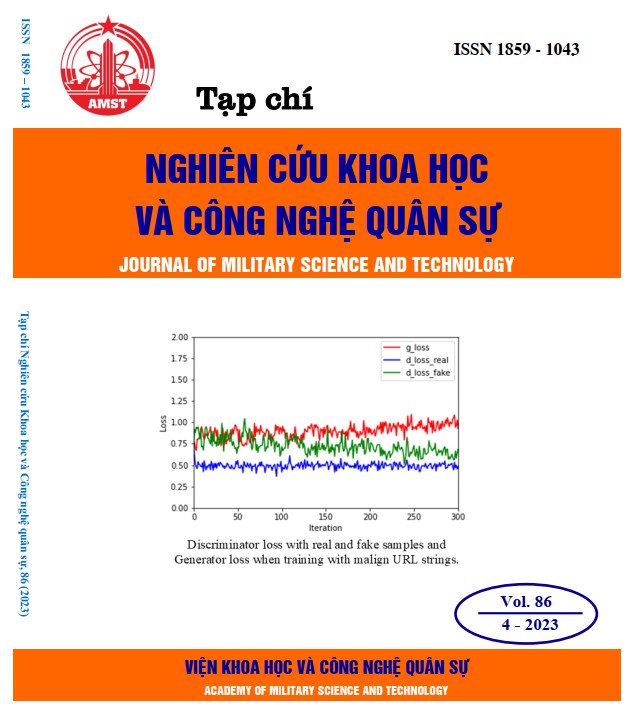Nghiên cứu xử lý màu và COD trong nước thải dệt nhuộm bằng giải pháp AOPs/UV kết hợp tiền xử lý keo tụ
607 lượt xemDOI:
https://doi.org/10.54939/1859-1043.j.mst.86.2023.86-94Từ khóa:
Nước thải dệt nhuộm; Keo tụ; AOPs/UV; H2O2/UV; S2O82-/UV; O3/UV; Xử lý màu; Xử lý COD.Tóm tắt
Trong nghiên cứu này, COD và độ màu của nước thải dệt nhuộm được nghiên cứu xử lý bằng các quá trình oxy hóa nâng cao dựa trên tia cực tím (AOPs/UV) kết hợp tiền xử lý keo tụ. Kết quả nghiên cứu cho thấy, quá trình tiền keo tụ có thể loại bỏ 49% COD (432 mg/L) và 50% độ màu (465 Pt-Co). Quá trình xử lý sau đó bằng phương pháp AOPs/UV sử dụng chất oxi hóa O3 được xác định là hiệu quả nhất với hiệu suất xử lý COD và độ màu tương ứng lên đến 96% (32 mg/L) và 95% độ màu (45 Pt-Co), đạt tiêu chuẩn xả thải cao nhất của nước thải công nghiệp dệt nhuộm hiện hành. Trong khi đó, các quá trình xử lí AOPs/UV sử dụng tác nhân oxy hóa S2O82- và H2O2 cho hiệu các hiệu suất xử lý COD lần lượt là 84% (134 mg/L) và 75% (214 mg/L); hiệu suất khử màu tương ứng lần lượt là 75% (214 mg/L) và 85% (127 Pt-Co). Kết quả nghiên cứu có thể định hướng công nghệ cho hệ thống xử lý với phương pháp tiếp cận khác biệt so với những hệ thống xử lý vi sinh, hóa lý truyền thống. Giải pháp AOPs/UV kết hợp với tiền xử lý keo tụ có thể sử dụng như một phương pháp hiệu quả để xử lý COD và độ màu trong nước thải dệt nhuộm.
Tài liệu tham khảo
[1]. Hutagalung, S.S., et al., "Textile Wastewater Treatment using Advanced Oxidation Process (AOP)". IOP Conference Series: Materials Science and Engineering, Vol. 722, pp. 1-9, (2020). DOI: https://doi.org/10.1088/1757-899X/722/1/012032
[2]. Yonar, T. and M.Y. Kilic, "Chemical oxygen demand and color removal from textile wastewater by UV/H2O2 using artificial neural networks". Water Environ Res, Vol. 86, No. 11, pp. 2159-2165, (2014). DOI: https://doi.org/10.2175/106143014X14062131178277
[3]. Ramos, P.B., et al., "Treatment of real non-biodegradable wastewater: Feasibility analysis of a zero-valent iron/H2O2 process". Journal of Environmental Chemical Engineering, Vol. 8, No. 4, pp. 103954, (2020). DOI: https://doi.org/10.1016/j.jece.2020.103954
[4]. Dinçer, A.R., "Increasing BOD5/COD ratio of non-biodegradable compound (reactive black 5) with ozone and catalase enzyme combination". SN Applied Sciences, Vol. 2, No. 4, pp. 1-10, (2020). DOI: https://doi.org/10.1007/s42452-020-2557-y
[5]. Quyen, V. and X.-T. Bui, "Removal of Non-Biodegradable Organic Matters from Membrane Bioreactor Permeate By Oxidation Processes", pp. 13-23. (2011).
[6]. Anh, N.T., et al., "Xử lý nước thải dệt nhuộm bằng quá trình oxy hoá bậc cao kết hợp với UV". Journal of science of Lac Hong university, Vol. 9, pp. 47-52, (2020).
[7]. Suryawan, I.W.K., et al., "Laboratory scale ozone-based post-treatment from textile wastewater treatment plant effluent for water reuse". Journal of Physics: Conference Series, Vol. 1456, No. 1, (2020). DOI: https://doi.org/10.1088/1742-6596/1456/1/012002
[8]. Wantoputri, N.I., et al., "Reactive Black-5 Removal by Ozonation as Post Treatment". IOP Conference Series: Materials Science and Engineering, Vol. 536, No. 1, pp. 1-7, (2019). DOI: https://doi.org/10.1088/1757-899X/536/1/012069
[9]. Baird, R.B., et al., 2120 Color, in Standard Methods For the Examination of Water and Wastewater. American Public Health Association, (2018).
[10]. Baird, R.B., et al., 2130 Turbidity, in Standard Methods For the Examination of Water and Wastewater. American Public Health Association, (2018).
[11]. Baird, R.B., et al., 4500-H pH, in Standard Methods For the Examination of Water and Wastewater. American Public Health Association, (2018).
[12]. Baird, R.B., et al., 5220 Chemical oxygen demand (COD), in Standard Methods For the Examination of Water and Wastewater. American Public Health Association, (2018).
[13]. Turan-Ertas, T., "Biological and Physical-Chemical Treatment of Textile Dyeing Wastewater for Color and COD Removal". Ozone: Science & Engineering, Vol. 23, No. 3, pp. 199-206, (2001). DOI: https://doi.org/10.1080/01919510108962003
[14]. Karam, A., et al., "Coagulation/flocculation process for textile mill effluent treatment: experimental and numerical perspectives". International Journal of Sustainable Engineering, Vol. 14, No. 5, pp. 983-995, (2021). DOI: https://doi.org/10.1080/19397038.2020.1842547
[15]. Color and COD removal from textile waste water containing reactive dyes using coagulation and fenton’s oxidation, in The potential health and environmental impacts of exposure to hazardous natural and man-made chemicals and their proper management, (2012).
[16]. Guida, M., et al., "Optimization of Alum-coagulation/flocculation for COD and TSS removal from five municipal wastewater". Desalination, Vol. 211, No. 1, pp. 113-127, (2007). DOI: https://doi.org/10.1016/j.desal.2006.02.086
[17]. Safarikova, J., et al., "Influence of peptides and proteins produced by cyanobacterium Microcystis aeruginosa on the coagulation of turbid waters". Separation and Purification Technology, Vol. 118, pp. 49-57, (2013). DOI: https://doi.org/10.1016/j.seppur.2013.06.049
[18]. Pourgholi, M., et al., "Removal of Dye and COD from Textile Wastewater Using AOP (UV/O3, UV/H2O2, O3/H2O2 and UV/H2O2/O3)". Journal of Environmental Health and Sustainable Development, Vol. 3, pp. 621-629, (2018). DOI: https://doi.org/10.18502/jehsd.v3i4.223
[19]. Mounteer, A.H., et al., "Removing textile mill effluent recalcitrant COD and toxicity using the H2O2/UV system". Water Sci Technol, Vol. 60, No. 7, pp. 1895-1902, (2009). DOI: https://doi.org/10.2166/wst.2009.584
[20]. Wang, C.-W. and C. Liang, "Oxidative degradation of TMAH solution with UV persulfate activation". Chemical Engineering Journal, Vol. 254, pp. 472-478, (2014). DOI: https://doi.org/10.1016/j.cej.2014.05.116
[21]. Rezaee, A., et al., "Photochemical oxidation of Reactive Blue 19 Dye (RB19) in textile wastewater by UV/K2S2O8 process". Iranian Journal of Environmental Health, Science and Engineering, Vol. 5, pp. 95-100, (2008). DOI: https://doi.org/10.3923/jas.2008.1108.1112
[22]. Bộ Tài Nguyên Và Môi Trường, QCVN 13:2015/BTNMT - Quy chuẩn kỹ thuật quốc gia về nước thải công nghiệp dệt nhuộm, (2015).







